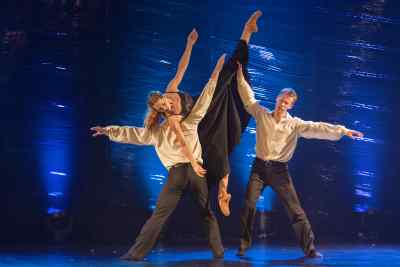 In the course of five autumn days in mid-October Slavonic Island and especially Žofín Palace came alive – as usual – with the International Television Festival Golden Prague. This year the festival, held continuously since 1964, has marked its 50th anniversary. In the last twenty years of its existence it has specialized in programme focused on music and dance, the visitors thus can watch recordings of concerts and opera and dance performances, as well as documentaries about famous personalities and dance and music movies.
In the course of five autumn days in mid-October Slavonic Island and especially Žofín Palace came alive – as usual – with the International Television Festival Golden Prague. This year the festival, held continuously since 1964, has marked its 50th anniversary. In the last twenty years of its existence it has specialized in programme focused on music and dance, the visitors thus can watch recordings of concerts and opera and dance performances, as well as documentaries about famous personalities and dance and music movies.Golden Saturday dominated by dance
Even before the opening ceremony, the Golden Day of Golden Prague took place on Saturday, October 12th at the Žofín isle and in the garden tent of the Žofín Palace, featuring dance performances, concerts, workshops and other activities for children and adults alike. On the stage there were performances by companies Dance Perfect, Children's Opera Prague, little ballerinas of the International Ballet School and students from Duncan Centre conservatory, Prague Dance Centre and Prague Dance Conservatory. Varied dance programme, which included a short demonstrations of classical repertoire, modern and contemporary dance was then the most important part of the whole "golden" afternoon. Those who went to the autumn cinema could even watch two interesting films about dance Hip hop Swan Lake and Dance My Heart Out, which were part of the festival competition selection. There were also numerous workshops focused on dance, those who were interested – no matter if grown ups or little – could try street dance, classical dance and Latin dances. The Saturday's opening concert in the Great Hall of the Žofín Palace was devoted to dance as well. During the one-hour programme leading Czech ballet and dance companies presented contemporary works as well as an excerpt of the classical repertoire. The evening opened with the Prague-based company Dekkadancers, performing part of the choreography Dotek Pakkáže, the authors of which are the principal dancers of the company Tom Rychetský and Viktor Konvalinka. After this piece, based on the collage of pop and electronic music followed a performance by the Prague Chamber Ballet, presenting an excerpt of their latest work The Condition of Disappearance choreographed by Korean Ji-Eun Lee. After contemporary dance a piece of classical repertoire was performed by the National Theatre Brno ballet soloists Eriko Wakizono and Ivan Popov, who danced a pas de deux from the ballet La Bayadére, choreographed by Jaroslav Slavický. The same company appeared on the stage at Žofín Palace once more in the course of the evening to perform a duet by contemporary Israeli choreographer Rami Beer called Butterflies (dancers Emma Vuorio and Adam Sojka). A large part of the evening was devoted to the South Bohemian Ballet of České Budějovice, the dancers of which performed a dance humoresque based on relationships Rozladěné/Odd couples choreographed by the ensemble’s current artistic director Attila Egerházi. The National Theatre Ballet presented themselves at the at the gala concert of Golden Prague in chamber pieces – soloists Alexander Katsapov, Nikola Márová and Viktor Konvalinka performed a trio based on the music by band Hradišťan Ej, lásko choreographed by the head of the ballet company Petr Zuska. Dancers of the Prague's first scene Ivanna Illyenko and Jiří Kodym then ended the evening with a duet based on Jacques Brel’s song Ne me quitte pas, which is a part of the very popular ballet Brel-Vysotsky-Kryl/Solo for three by Petr Zuska.
Video library and dance films premieres From Sunday morning Great Hall at Žofín was transformed into the festival video library, where visitors could watch a total of ninety movies, entering the festival. There were forty separate booths with a TV set and two pairs of headphones. A novelty was that all shows entering the competition had been already recorded in every TV set so viewers could easily and instantly watch the program of their choice without the (sometimes lengthy) waiting for the DVD, which happened in the past when there were only three copies of each film available.
Among the most watched movies from the dance world was a sequel to the documentary on Czech prima ballerina Daria Klimentová – Life in Dance. This captivating film by Martin Kubala, depicting the past six years in the life of the dancer (from 2007 to 2012) eventually won the Audience Award at the festival. The director and cinematographer in less than an hour captures Daria in both her professional and private life, depicts her daily routine, wonderf
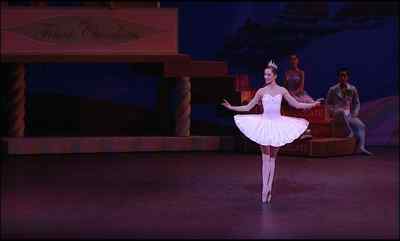 ul dance performances, new encounters (e.g. with her current dance partner Vadim Muntagirov), tours around the world, but also the growth of her daughter Sabinka who, year after year, changes her mind on what she wants to be in life. Although Daria at the very beginning of the documentary claims that her active career will end very soon (the documentary was originally to capture her farewell to the stage), but instead come new roles, awards, challenges and encounters that make the prima ballerina find new vigour and she enjoys dancing perhaps more than ever before.
ul dance performances, new encounters (e.g. with her current dance partner Vadim Muntagirov), tours around the world, but also the growth of her daughter Sabinka who, year after year, changes her mind on what she wants to be in life. Although Daria at the very beginning of the documentary claims that her active career will end very soon (the documentary was originally to capture her farewell to the stage), but instead come new roles, awards, challenges and encounters that make the prima ballerina find new vigour and she enjoys dancing perhaps more than ever before.Similar in genre, but completely different in treatment was a documentary film from 2012 about the Ukrainian prima ballerina Heaven Born Dancer: Prima Ballerina Elena Filipieva. It introduced the career of the famous dancer who started to host as a soloist in a theatre already during her studies at the Conservatory and whose fame soared to astronomical heights. Very helpful to her was also the ballet legend Maya Plisetskaya, who claimed her to be the best dancer she had ever seen. In addition to the story told by ballerina herself and her colleagues we could also see in this documentary long film sequences of most of her principal roles (alas, most of them were of very poor quality).
Very interesting and frequently watched was the Swedish film Dance My Heart Out, which documents the progress of the work of the famous Swedish choreographer Mats Ek with the Cuban ensemble Danza Contemporánea de Cuba. This professional dance company is very specific as both to the assemblage of dancers and their individual styles and situation in which they have to live and work. It is one of the poorest professional ensembles in the world, therefore hosting a star such as Mats Ek would be under normal circumstances only a utopian dream to them. However, the choreographer offered them within a framework of a charity project to rehearse his choreography Casi casa (Apartment) with them completely free of charge. The documentary depicts a rather uneasy emergence of the piece, hampered by many complications: a completely different way of working the dancers were not used to and initially found difficult to adapt to, language barriers, injuries, financial problems and even political censorship, all that made it difficult for Mats Ek. Eventually, however, all was put up together in time, resulting in a successful premiere at the Gran Teatro de la Habana and a subsequent world tour. Viewers of this documentary have an opportunity to experience the sometimes incredible working and living conditions of dancers who, despite all the hardships love what they do and work the best they can. According to Mats Ek they work even more than anyone else in the country.
Another in the series of documentaries about famous personalities was a short film of the 2012 Wild in Art: Vladimir Malakhov undercover at Berlin. This movie full of enthusiasm depicts a project in which Vladimir Malakhov, the famous Russian dancer and currently the head of the Berlin Opera Ballet staged a flash mob in Berlin Sony Center. Its purpose is to bring together a group of professionals, amateurs and children to rehearse a choreography to the music of Dirty Dancing and then dance it together in front of stunned passers-by in the commercial centre of Berlin. We see Malakhov incognito in an aerobics class or how he curls his hips like John Travolta along with women of all ages and little ballerinas rehearsing the same piece as the experienced professional dancers. After several weeks of frenzied preparations the flash mob eventually took place and the enthusiasm of the audiences was really huge.
In comparison, Italian documentary William Forsythe: Mind, Body, Counterpoint by the director Francesca Pedroni is very concentrated and reflective. It was created on the occasion of staging of Forsythe's new piece Studio # 1 (2011) at the Teatro Grande di Brescia, the atmosphere and beautiful space of which completely captivated the choreogřapher. When creating Studio # 1 he thus drew on the environment he was in. In the documentary he also explains the principles of his work, which is based on dispositions of every dancer, on improvisation and the environment as well as on the sounds and music. He is interested primarily in the creative process, mutual inspiration with dancers and motion research as such. A great emphasis is therefore placed on his dancers and other colleagues who have been for many years engaged in choreographer's research and helped to create an innovative way of working that William Forsythe is famous for.
In addition to documentaries the Golden Prague festival also featured interesting productions filmed at various scenes around the world. For instance, one of the important events of the last season was the centenary of the performance of Rite of Spring, the premiere of which was given by the company Les Ballets Russes in Paris in 1913. On this occasion a performance Les 100 ans du Sacre de Printemps, recorded by French TV ARTE, was given at the Théâtre des Champs - Élysées (the venue of the original premiere). In the course of the evening the ballet ensemble of the Mariinsky Theatre in St. Petersburg performed two versions of the famous ballet: first of them was the reconstruction of the original choreography by Vaslav Nijinsky, made by Millicent Hodson in 1987, the second one was one of the most recent versions choreographed by Sasha Waltz.
From Paris, this time directly from the Opera, was also a record of a short ballet Sous Apparence (2012), the first choreographic attempt by a primaballerina of the local ballet company Marie-Agnés Gillot. In this extravagant piece to the music by Morton Feldman, Anton Bruckner and György Ligeti all male and female dancers performed in pointe shoes, creating different geometric shapes and often venturing into risky actions.
Of the full-length ballets the festival visitors could watch The Nutcracker performed by the Vienna Opera Ballet in a choreography by Rudolf Nureyev, staged by Manuel Legris and Aleth Francillon (a short documentary Nutcracker - Behind the scenes was filmed by Florian Gebauer on staging of the production); Romeo and Juliet from the Mariinsky Theatre in St. Petersburg, which is still being performed in the original version of 1940 by Leonid Lavrovsky, or a modern version of Swan Lake by the French choreographer Jean-Christophe Maillot performed by Les Ballets de Monte Carlo. Golden Prague also features prestigious premiere screening of some films, during which the audiences can meet the creators of the film and ask them few questions as well.
Among the featured dance films was a Slovak movie from 2012 Tanec mezi střepinami that was presented by director and lead actor in one person Marek Ťapák. This dance film that is going to be featured in the Czech cinemas as well tells a story of a mature man, meetings with his femmes fatales and
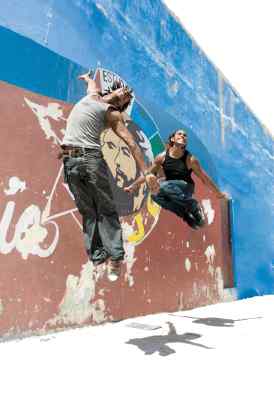 other life events. Rather than a linear narrative it consists of a series of poetic images, images of beautiful Slovak landscapes, fragmentary scenes of life, but most of all an ubiquitous folk dance. People are dancing in the mountains, in the woods, in a tavern, in a room, on the field, in the water... Anyway, it is difficult to accurately determine the time and space in which all this happens. The featured music and dance is in fact a mixture of Slovak, Hungarian, Romanian and Polish folk songs and rhythms, it is a kind of selection of the best (or most spectacular) from the region of historic Hungary. The author of the film Marek Ťapák encourages viewers not to seek any logic in it and just let themselves get carried away by beautiful images and emotions that the film tries to evoke. The images are really impressive and dance performances outstanding, however, greater profundity or comprehensive and realistic view of folk life is clearly missing here.
other life events. Rather than a linear narrative it consists of a series of poetic images, images of beautiful Slovak landscapes, fragmentary scenes of life, but most of all an ubiquitous folk dance. People are dancing in the mountains, in the woods, in a tavern, in a room, on the field, in the water... Anyway, it is difficult to accurately determine the time and space in which all this happens. The featured music and dance is in fact a mixture of Slovak, Hungarian, Romanian and Polish folk songs and rhythms, it is a kind of selection of the best (or most spectacular) from the region of historic Hungary. The author of the film Marek Ťapák encourages viewers not to seek any logic in it and just let themselves get carried away by beautiful images and emotions that the film tries to evoke. The images are really impressive and dance performances outstanding, however, greater profundity or comprehensive and realistic view of folk life is clearly missing here.The second premiere from the dance world was a Swedish Hip hop Swan Lake, choreographed by street dancer Fredrik "Benke" Rydman. Even when reading the title of this film many lovers of classical ballet will see the red warning light. And from this point of view the film really comes up to expectations. In this version Rothbart is a drug dealer, swans are prostitutes addicted to heroin, the prince's mother and friends are into cocaine. Drugs are therefore the "magic" that the "sorcerer" controls the others with. Only the prince is free of addiction, so he can fight against evil and try to save one of the swans he has fallen in love with. Reinterpretations of classical ballet do not surprise or shock much these days anymore, what really matters is the nature and quality of rendition. However, Hip hop Swan Lake cannot do without cliches and even does not impress much from the dance point of view, although street dance and hip hop are otherwise very impressive dance forms. From Tchaikovsky's original score only the best-known tunes are used, which are further mixed in a rather ill-chosen way and then completely drowned with electronic and pop music. Even some rather interesting film effects will not save the production. The question is whether the author wanted to attract young audiences with his reinterpretation of the "classics", or just use the well-known title to win the attention of wide audience. In any case, he managed to leave an impression at least in Sweden and his productions is very successful there.
Tributes to dancers and choreographers, or, ballet stars at the Golden Prague
The accompanying program traditionally includes the cycle Tribute to... that every year introduces several leading personalities from the world of music and dance, while more and more emphasis has been recently placed on ballet.
This year the festival featured star-studded guests indeed. The first Tribute to... that took place on Sunday, October 13th was devoted to Jiří and Otto Bubeníček, the famous Czech dancers working mainly abroad. They came to Prague to talk about their successful careers, their presentation was highlighted with many video shots. They recalled their beginnings at the Prague Dance Conservatory, their first encounter with the choreographer John Neumeier and subsequent years of engagement in The Hamburg Ballet. Neumeier grew very fond of these "ballet twins" and created several roles in his ballets especially for them – brothers therefore could pick some absorbing excerpts of ballets like Illusions – like Swan Lake and Nijinsky, excerpts from the documentary Die Ballettzwillinge made about them by a German TV in 2003 were not missing either. Jiří then spoke about his moving to Dresden and beginnings in a new role of a choreographer, Otto then gave a presentation on how he makes music and stage design for his brother’s projects. They ended the evening with an invitation to their upcoming Prague performances, which take place on 11th and 12th January 2014. The event was hosted by opera director, publicist and the brothers’ friend Pavol Juráš, who, however, was in the course of the evening vacillating between a professional discussion and a friendly chat, during which he even revealed some details of the private life of the brothers, which left a somewhat embarrassing impression. Anyway, with their personal charm and relaxedness, as well as beautiful demonstrations of their art the dancers enthralled the audiences that crammed in the Small hall at Žofín.
The second Tribute to... was dedicated
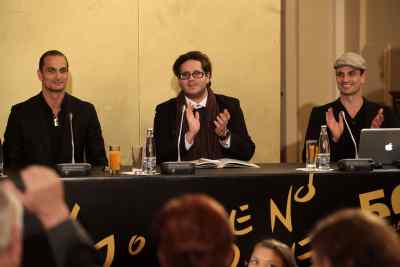 to a dance legend of the 20th century Maurice Béjart. The evening was hosted by a well-known German producer of films on art Reiner Moritz, who was directly involved in the shooting of some of Béjart’s ballets. He thus chose several examples of high-quality films, which gave an idea of the oeuvre of French choreographer working primarily in Belgium. These included both the original productions of Béjart’s Ballet du XXme Siècle (eg. Rite of Spring filmed in 1968) and Ballet Lausanne (The Nutcracker from 2001) and new stagings of his works by the Paris Opera Ballet (The Firebird and Le Bolero, filmed in 2008). An excerpt from the ballet Chair inspired by a play by J.-P. Sartre, danced by Marcia Haydée and John Neumeier was interesting too. The audiences had a unique opportunity to see some rare film materials and recall Béjart’s unique oeuvre that even after years has lost nothing of its intensity.
to a dance legend of the 20th century Maurice Béjart. The evening was hosted by a well-known German producer of films on art Reiner Moritz, who was directly involved in the shooting of some of Béjart’s ballets. He thus chose several examples of high-quality films, which gave an idea of the oeuvre of French choreographer working primarily in Belgium. These included both the original productions of Béjart’s Ballet du XXme Siècle (eg. Rite of Spring filmed in 1968) and Ballet Lausanne (The Nutcracker from 2001) and new stagings of his works by the Paris Opera Ballet (The Firebird and Le Bolero, filmed in 2008). An excerpt from the ballet Chair inspired by a play by J.-P. Sartre, danced by Marcia Haydée and John Neumeier was interesting too. The audiences had a unique opportunity to see some rare film materials and recall Béjart’s unique oeuvre that even after years has lost nothing of its intensity.The culmination of the festival was, at least for ballet lovers, an encounter with a living legend, choreographer and head of The Hamburg Ballet John Neumeier. He came to Prague to explain to the festival visitors his work in relation to a film camera. He was welcomed by Yvona Kreuzmannová, director of Tanec Praha festival and ballerina Adéla Pollertová, who recalled her ten-year collaboration with him from the perspective of a former dancer of The Hamburg Ballet. Neumeier’s very thoroughly made presentation included rare examples of both old and recent works, which the choreographer always commented on and emphasized what he wanted to achieve in the process of shooting of his ballets.
At the very beginning John Neumeier mentioned how important the dance film for his career – and actually for him to eventually become a dancer and choreographer – was. He has been watching movies with dancing in them on TV since his childhood and later thanks to shooting of his first choreography HQ he got basic feedback on his work .
As a choreographer he continued to be entangled with film, for instance during the shooting of his ballet The Legend of Joseph, created for the Vienna ballet company. Sample of the film version of the ballet from 1977, which was filmed in two weeks was now screened at the Prague fe
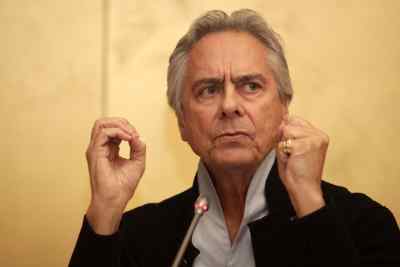 stival for the first time.
stival for the first time.For this and many other film versions of his ballets he also sat in the director’s chair while he was fully aware that ballet and dance film were two very different disciplines and it was necessary to work in different ways with them. Thus when shooting he was not afraid of changes in the original structure of the ballet, realistic stage set and close-up shots, due to which he achieved greater emotionality and more powerful effect on the viewer. This was beautifully illustrated by excerpts from the ballet The Lady of the Camellias, the film version of which was made in 1987, featuring Marcia Haydée and Ivan Liška. This was then compared with a later production at the Paris Opera, which was filmed from a performance in 2009. There are obvious differences that lessen the impression of the later film, which is indeed of a very good quality, but somewhat reserved when it comes to emotions.
From his recent productions were featured excerpts from Death in Venice from Baden -Baden (2004) and The Little Mermaid, which was filmed in San Francisco in 2011. Both aroused a rave applause from the audiences and surely stirred their desire to see both ballets in their entirety.
John Neumeier is a very charismatic persona, has a great sense of music and manifestation of emotions through movement, gesture and expression.
On Wednesday, October 16th the Golden Prague festival officially concluded with a final concert and award ceremony. The main prize of the Golden Prague festival was awarded to the Austrian documentary film Journey of a Lifetime about the life and work of co
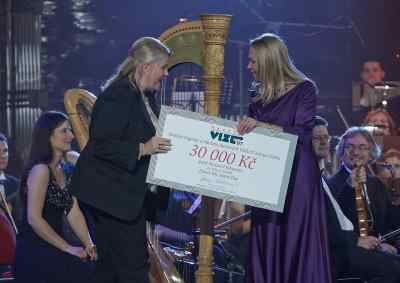 nductor Georg Solti. Audience Award went to the Czech Television film Daria Klimentová – Life in Dance, created by director and cinematographer Martin Kubala. The award in the category of Performing arts, which means music and dance programs, including the recordings of concerts was given to the movie Lake. Studio recording of the famous ballet in the interpretation of choreographer Jean-Christophe Maillot will, according to the jury, "enchant the audience by stunning interpretation of Tchaikovsky’s masterpiece through modern dance." The Dagmar and Václav Havel Foundation VIZE 97 award went to the film Dance My Heart Out by Swedish television SVT.
nductor Georg Solti. Audience Award went to the Czech Television film Daria Klimentová – Life in Dance, created by director and cinematographer Martin Kubala. The award in the category of Performing arts, which means music and dance programs, including the recordings of concerts was given to the movie Lake. Studio recording of the famous ballet in the interpretation of choreographer Jean-Christophe Maillot will, according to the jury, "enchant the audience by stunning interpretation of Tchaikovsky’s masterpiece through modern dance." The Dagmar and Václav Havel Foundation VIZE 97 award went to the film Dance My Heart Out by Swedish television SVT.As every year the festival offered the dance enthusiasts many wonderful experiences and encounters. It is a truly unique event and we can indeed look forward to what the next, fifty-first year brings.
Golden Prague festival
12th to 16th October 2013, Žofín Palace



